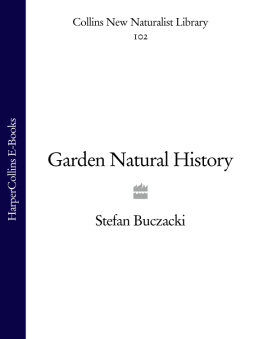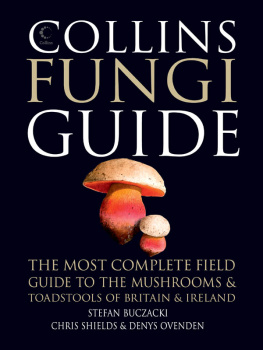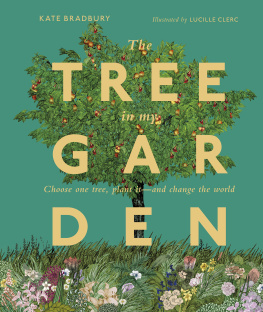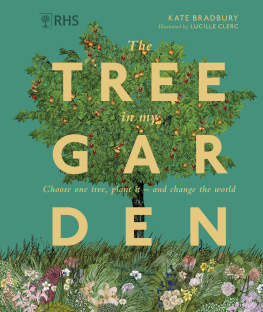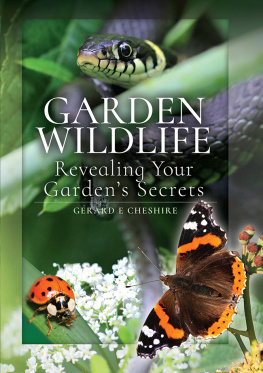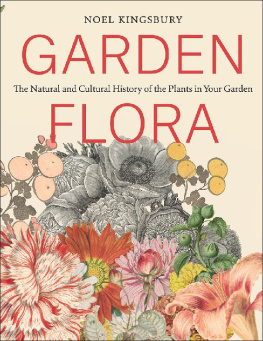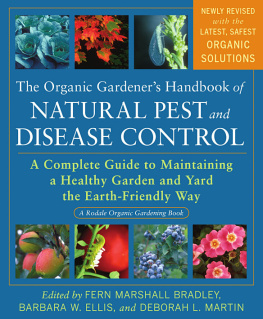EDITORS
SARAH A. CORBET, ScD
PROF. RICHARD WEST, ScD, FRS, FGS
DAVID STREETER, FIBIOL
JIM FLEGG, OBE, FIHORT
The aim of this series is to interest the general reader in the wildlife of Britain by recapturing the enquiring spirit of the old naturalists. The editors believe that the natural pride of the British public in the native flora and fauna, to which must be added concern for their conservation, is best fostered by maintaining a high standard of accuracy combined with clarity of exposition in presenting the results of modern scientific research.
F OR MANY PEOPLE, a garden is the only easily accessible place to see plants and animals, and gardening provides the readiest opportunity for interacting with the natural world. The natural history on the doorstep deserves wider recognition. Although gardening is an exercise in applied natural history, there are few publications that introduce the cast and encourage observers to follow the ecological dramas unfolding under the leaves or in the compost heap. In this book, Stefan Buczacki reviews the diversity of organisms and processes waiting to be explored. Integrating gardening lore with horticultural and ecological science, he interprets familiar observations. He also offers gardeners recommendations for management to enhance wildlife, together with ideas that will enrich their appreciation of horticultural natural history. It is hoped that this much-anticipated addition to the New Naturalist series will stimulate further work on this relatively unexplored, yet accessible, world, and encourage gardeners to notice, perhaps even welcome, the unplanned diversity of organisms, often uninvited, that shares the garden.
Well known as an author and broadcaster on various aspects of gardens and gardening, and a connoisseur of New Naturalists, owning a complete collection of titles, Stefan Buczacki is the ideal author for a New Naturalist on Garden Natural History. We are delighted that he accepted the invitation to write this book for the series.
A PART FROM Max Walters Wild and Garden Plants, no previous New Naturalist volume has considered gardens in any other than a fleeting and superficial manner, let alone had the word garden in its title. To a naturalist like myself who is also a gardener, this seems an astonishing omission. It is nonetheless an understandable one, as the garden has for long been considered something wholly artificial that has little in common with or relevance to natural habitats, somewhere that has no part to play in A Survey of British Natural History. I am privileged to be able to rectify the omission and correct the record, although for someone who thought the task would be straightforward, the exercise has proved a daunting journey of discovery. At the outset, I believed I had simply to tell a story based on my own lifetimes experience and observations in natural history and horticulture, and substantiate it with data from the scientific literature. But there was the rub. I had not reckoned on how tiny, disparate and perfunctory was the scientific literature, how sparse the studies of garden wildlife. Apart from birds, almost no group of organisms that live in gardens have been studied in relation to this particular habitat in any depth. Even the scientific literature of commercial horticulture was of little help, because arable cropping is so different in approach, practice and scope from domestic gardening.
The realisation that I had rather few facts to support my beliefs and ideas has resulted in a book that may be perceived as judgemental, dogmatic and opinionated. I make no apology for that, and whether readers agree or disagree with the views I have expressed and the conclusions I have drawn, I can only articulate the fervent wish that those in a position to do so will now take matters into their own hands. I hope my fellow scientists will at last view the garden seriously, recognise its huge importance in the overall context of a threatened environment, and embark on the studies that are so urgently needed to show how it can most effectively be used and managed for the complementary purposes of enjoyment and conservation.
It is my pleasure to acknowledge with real gratitude the patience, understanding and forbearance of Myles Archibald and the Natural History staff at HarperCollins and the support and confidence expressed in me by the New Naturalist Editorial Board.
CHAPTER 1
British Gardens the Background
A GARDEN IS An enclosed piece of ground devoted to the cultivation of flowers, fruit or vegetables, often with defining word, as flower-, fruit-, kitchen- etc.; alternatively, it means Ornamental grounds, used as a place of public resort (OED). Today, without adjectival qualification, it carries two connotations: first, that it is essentially a non-commercial undertaking; and second, that it is attached to or associated with a dwelling place. These meanings are what I intend here, a consideration of what is sometimes called, certainly in North America, the home garden. Add an adjective (market, botanic) and it can have other meanings, and although I shall have a few things to say about the botanic garden, the market garden is in effect a small arable farm and falls largely outside my scope.
Historically, it is impossible to see where farms end and gardens begin, but what can loosely be called the artificial management of plants has been a feature of human society for at least 10,000 years. It is known to have developed first in the area we now call the Middle East, especially the region presently occupied by Israel, Iran, Syria and Iraq, and it later spread from there to other parts of the eastern Mediterranean. Recent studies by a British and American research team at a site called Abu Hureyra have not only narrowed the likely geography to Syria, but also extended the timescale to a date around 13,000 BP (Moore et al., 2000). The Abu Hureyra village discoveries neatly linked the first farmers to a hunter-gatherer culture that existed in the same locality for around 400 years before the growing of cereals, including rye, first began. These studies therefore place the origins of plant cultivation in the Late Upper Palaeolithic period, when the glaciers of the last ice age were still retreating from northern Europe. Later still, the organised growing of crops began in India, China and South America, so that by around 4,000 BP it was an established feature of societies in many parts of the world.
EARLY CULTIVATION OF PLANTS IN BRITAIN
In Britain, plants were being cultivated at an early date at the village site of Skara Brae on Orkney which, following its discovery in the mid-nineteenth century and preliminary study in the early twentieth, was at first believed to be an Iron Age Pictish settlement. Following radiocarbon dating in the 1970s, however, Skara Brae was reinterpreted as Neolithic and is now known to have been inhabited between 5,200 and 4,200 BP (Fig. 1). Recent studies elsewhere on Orkney suggest that plants may have been grown at an even older locality which would push the origins of British crop cultivation back to around 6,000 BP. But the growing of crops does not make a garden. For me, a garden is an area that gives at least a modicum of pleasure as well as practicality to its owners. Here, however, the archaeological record can do little more than provide pointers, and precisely when the use of gardens for any sort of decoration first began is obscure. Quite possibly it arose through the careful choice of some of the more attractive among edible crops, herbs for instance, or, even earlier, I have often thought, through the deliberate growing close to
FIG 1. Skara Brae on Orkney was inhabited between 5,200 and 4,200 BP and is probably one of the first sites in the British Isles at which plants were cultivated.

